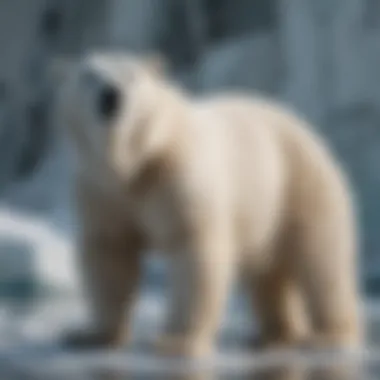Impact of Climate Change on Global Biodiversity


Overview of the Topic
Climate change has emerged as one of the most pressing environmental issues of our time, with its effects permeating various facets of our world. The continual rise in global temperatures, shifting precipitation patterns, and altering ecosystems are creating circumstances that challenge the survival of myriad species. This complex web of interaction between climate variables and biological adaptations is multifaceted and deserving of scrutiny.
Understanding the significance of this topic requires a look at the ongoing transformations within ecosystems that house innumerable species. Wildlife is not insulated from the impacts of climate fluctuations. Rather, many species find themselves navigating a precarious landscape where survival and reproduction hinge on their ability to adapt swiftly to the rapidly changing environment. The interconnectedness of ecosystems means that the effects reverberate through communities and across geographical boundaries, raising urgent concerns about biodiversity loss.
Current Status and Challenges
As of now, a staggering number of species are facing challenges attributable directly to climate change. Recent studies indicate that an estimated one million species are on the brink of extinction, with climate factors frequently cited in their decline.
Challenges Facing Biodiversity
- Rising Temperatures: The increase in average global temperatures disrupts seasonal patterns, affecting hibernation, migration, and breeding. Some species are struggling to cope, leading to reduced populations.
- Altered Precipitation Patterns: Changes in rainfall can lead to droughts or floods, impacting habitats significantly. For instance, coral reefs are highly sensitive to temperature and salinity changes, leading to widespread bleaching and habitat loss.
- Shifting Ecosystems: Ecosystems are in a state of flux as species migrate in response to climate changes. As some adapt and remain, others may be displaced, leading to potential imbalances.
"Adaptation does come at a cost. Many species can only move so far before they hit barriers, leading to population isolation and eventual decline."
Sustainable Solutions
While the challenges may seem overwhelming, multiple sustainable practices offer hope and direction in addressing these issues. Conservationists and researchers are developing innovative strategies aimed at mitigating the impacts of climate change on species.
Examples of Effective Resource Management:
- Habitat Restoration: Initiatives aimed at restoring degraded habitats can help encourage biodiversity. Natural habitats need to be preserved and revitalized, allowing for species to thrive.
- Protected Areas: Establishing wildlife reserves and protected areas can safeguard vulnerable species from climate impacts, giving them a better chance to adapt and reproduce.
- Community Involvement: Programs that engage local communities in conservation efforts have been effective in educating about sustainable practices and protecting local biodiversity.
Impact and Importance
The ramifications of climate change on species extend well beyond the immediate effects on individual organisms. Ecosystems function as intricate networks, and the loss of a single species can have cascading effects throughout the food web. The implications also stretch into human life, influencing food security, health, and even economic stability. Future generations will undoubtedly inherit the legacy of our current choices, making it imperative that action is taken promptly.
Conservation efforts are not just about protecting flora and fauna; they are about building resiliency within ecosystems for years to come. Understanding the links between climate change and species adaptation is essential for nurturing a future where biodiversity can flourish alongside human development. By focusing on sustainable practices and interventions, communities can ensure that the balance of nature is preserved, safeguarding ecosystems for the next wave of life.
Preamble to Climate Change and Biodiversity
The interplay between climate change and biodiversity is a pressing issue that has garnered significant attention in recent years. Understanding how climate change affects various species is paramount not only for scientists and conservationists but for society as a whole. As climates wax and wane, the urgency to comprehend these shifts becomes clear, especially when considering the long-term implications on ecosystems.
Climate change fundamentally alters weather patterns, leading to fluctuations that many species struggle to navigate. In this section, we will explore the core concepts of climate change and biodiversity while providing insights into their interplay. The advantages of grasping this relationship extend beyond academic circles, influencing policies, conservation efforts, and our collective response to environmental challenges.
The benefits of an in-depth analysis of climate change and biodiversity are manifold. Crucially, recognizing the impacts on species allows us to formulate effective conservation strategies. By understanding which species are at risk, policymakers can prioritize resources and efforts accordingly. This alignment of knowledge and action is vital as ecosystems play a critical role in maintaining the health of our planet.
Furthermore, this knowledge aids in fostering greater public awareness. Educating various stakeholders, from students to environmental enthusiasts, about these trends can catalyze grassroots movements aimed at addressing climate issues. Simply put, informed individuals can make choices that promote biodiversity preservation, whether it's through sustainable practices or supporting conservation initiatives.
In summary, the examination of climate change on biodiversity is not merely an academic exercise; it is a necessary inquiry into the nature of existence on Earth. This article endeavors to provide a comprehensive foundation, setting the stage for a deeper exploration into the mechanisms of climate change impacts on various species. Understanding this connection instills a sense of responsibility toward protecting the natural world for generations to come.
Understanding Climate Change
At its core, climate change refers to significant shifts in weather patterns and global temperatures over extended periods. It’s a phenomenon driven primarily by human activity, notably the burning of fossil fuels, leading to an accumulation of greenhouse gases in the atmosphere. This ceaseless increase results in global warming, which manifests in various forms such as rising sea levels, altered precipitation patterns, and unprecedented weather events.
The persistence of high emissions could result in catastrophic consequences. For instance, ecosystems, such as wetlands and forests, struggle to adapt to rapidly changing conditions. Species that are less mobile or specialized may find themselves on a fast track toward extinction if they cannot adjust quickly enough. Conversely, species with broader tolerances or higher reproductive rates might thrive—but at what cost?
Defining Biodiversity
Biodiversity encompasses the variety of life in a given ecosystem, covering the diversity within species, between species, and the variance among ecosystems themselves. In simpler terms, it can be thought of as the intricate tapestry of life that makes our planet vibrant and thriving. However, biodiversity is more than just an assemblage of various organisms; it is a key factor that contributes to ecosystem resilience.
A rich biodiversity fosters greater stability. Ecosystems with a varied array of species are generally more capable of withstanding environmental stresses, such as those imposed by climate change. This interdependence highlights the critical importance of each organism, no matter how large or small.
Also, biodiversity provides significant benefits to humanity. Ecosystems rich in diversity often offer essential services—think clean air, water purification, and nutrient cycling. Thus, any significant loss in biodiversity could have ripple effects, impacting not just nature but human wellbeing too.
"In the face of climate change, preserving biodiversity is tantamount to safeguarding our future."
Understanding climate change and biodiversity is like piecing together a puzzle. Each insight adds to a larger picture of how our planet functions, which is vital in addressing the challenges that lie ahead.
Mechanisms of Climate Change Impact on Species
Understanding how climate change affects species and ecosystems is vital in the broader conversation about sustainability and conservation. This section aims to delineate the specific mechanisms through which climate change manifests its impact, particularly focusing on temperature increases and altered precipitation patterns. These elements are critical in understanding the tangible effects on biodiversity, as they underpin physiological responses and ecological shifts that threaten many species.
Temperature Increases
Rising global temperatures are a hallmark of contemporary climate change. This shift has implications that reverberate through entire ecosystems, affecting everything from small insects to large mammals.
Direct effects on physiology
The direct impact of warmer temperatures on species' physiology is profound. For instance, many organisms have evolved within specific temperature ranges that support their metabolic processes. As temperatures rise, we see alterations in growth rates, reproductive success, and even survival.
- Key Characteristic: Various species exhibit temperature upper limits, beyond which physiological stress occurs. This stress can lead to impaired reproduction or even mortality.
- Importance: Addressing how temperature affects physiology is essential for zoologists and ecologists; it provides predictive power about which species might be at risk as conditions change.
- Unique Feature: Many ectothermic animals, like reptiles, depend heavily on external conditions for thermoregulation. For example, the American alligator must be within a certain temperature for optimal egg incubation. Rising temperatures may lead to skewed sex ratios, as temperature can influence the development of male versus female offspring.
- Advantages/Disadvantages: While some species may acclimate or even thrive in slightly altered conditions, many others, particularly those in sensitive habitats, face existential threats due to their limited adaptive capacity. Understanding these dynamics helps implement more effective conservation measures.
Alteration in biological rhythms
Changes in temperature also disrupt biological rhythms, which are critical for the timing of life cycle events like reproduction and migration. When temperatures shift significantly, organisms may misalign their reproductive cycles with environmental cues critical for offspring survival.


- Key Characteristic: Many species rely on environmental triggers that are closely linked to temperature changes. For example, the arrival of warmer weather prompts many bird species to migrate northward.
- Importance: Understanding these rhythms allows researchers to predict shifts in population dynamics and community interactions. If species do not align with their food sources or breeding partners in time, it could lead to declines or extinctions.
- Unique Feature: The reliance on temperature for these rhythms adds a layer of vulnerability for species; if the timing of seasonal events becomes unlinked due to climate change, cascading effects could dramatically alter ecosystems.
- Advantages/Disadvantages: Adjustments to biological rhythms can sometimes be beneficial, allowing species to capitalize on new conditions. However, in most cases, the lack of synchrony between life cycles can be detrimental, particularly for predator-prey relationships.
Altered Precipitation Patterns
Changes in precipitation are another mechanism through which climate change exerts pressure on species and ecosystems. These shifts can lead to droughts or increased rainfall, each with its own set of challenges.
Impact on habitat availability
Habitat loss due to altered precipitation can be devastating for various species. Water availability is essential for life, impacting food sources, breeding sites, and overall ecosystem health.
- Key Characteristic: Wetland ecosystems, for instance, are highly sensitive to changes in precipitation patterns. A reduction in rainfall can lead to habitat shrinkage, affecting wildlife reliant on such ecosystems.
- Importance: This aspect is crucial for conservationists; without adequate habitats, species face higher risks of extinction. Understanding these dynamics supports better habitat management strategies.
- Unique Feature: Certain species are particularly dependent on specific habitats. For instance, amphibians rely on moist environments for their breeding cycles, and any changes to these areas could threaten their life cycles.
- Advantages/Disadvantages: While some adaptable species may thrive in changing conditions, many specialized species face habitat loss that can precipitate rapid declines. Recognizing these vulnerabilities helps prioritize conservation efforts in hotspots.
Effects on food resources
Altered precipitation also influences food availability and, consequently, species interactions. The cyclical nature of ecosystems means that a shift in one element—like rainfall—can have a domino effect.
- Key Characteristic: Changes in precipitation affect plant growth, which in turn influences herbivores and, subsequently, carnivores.
- Importance: Understanding these food web dynamics enables ecologists to foresee potential points of failure within ecosystems, leading to better management practices.
- Unique Feature: For example, increased rainfall might initially support plant growth, but excessive water can lead to root rot and plant mortality, thereby reducing food available for herbivores.
- Advantages/Disadvantages: While some species can adapt to variable food resources, others may become desperate, leading to increased competition and potential conflicts within ecosystems.
Conclusion: The mechanisms by which climate change affects species are complex and multifaceted, necessitating a nuanced understanding to effectively address the challenges presented to biodiversity. Through this section, we explore these essential elements, laying the groundwork for further discussions surrounding the long-term impacts on the world's ecosystems.
Case Studies: Species at Risk
The significance of case studies in understanding the impact of climate change on various species cannot be overstated. These specific instances serve as poignant reminders of the realities faced by organisms as the planet transforms around them. By examining how particular groups are affected, we not only gain insight into the mechanisms of ecological change but also gauge the effectiveness of our ongoing conservation efforts. Moreover, these case studies highlight urgent priorities for policy action and public awareness.
Coral Reefs and Marine Biodiversity
Coral bleaching phenomena
Coral bleaching is a direct response to elevated water temperatures, which can cause corals to expel the symbiotic algae they depend on for nutrition. This relationship is crucial since the algae provide corals with their color and much of their energy through photosynthesis. When corals bleach, they face severe survival challenges, leading potentially to mass die-offs. This aspect makes coral bleaching a vital topic for this article, as it underscores the interconnectedness of marine ecosystems.
The key characteristic of coral bleaching is the loss of color and vitality. The bright white skeletons become exposed, signaling distress, which can resonate loudly across the food web. What stands out about this phenomenon is that it serves as an alarm bell for the health of marine environments. The consequences can be catastrophic, not just for the reefs but also for countless species that rely on these habitats for survival.
However, there are also certain disadvantages tied to coral bleaching. For instance, while it raises awareness about climate change, it can also lead to a false sense of security as some corals may recover under optimal conditions. Yet, that recovery is not guaranteed and often leads to long-lasting ecological changes that can affect marine biodiversity for generations.
Impact on reef-associated creatures
The impact of diminishing coral systems extends well beyond the reefs, significantly influencing marine biodiversity. A key aspect of this is that many marine species depend on coral reefs as breeding grounds and feeding areas. When corals decline, these species face habitat loss, leading to a ripple effect that can compromise entire ecosystems.
The unique feature of reef-associated species is their intricate relationships with coral structures. For example, many fish species exhibit specialized behaviors that depend on healthy reefs, allowing them to hide from predators and access food sources. In this article, this consideration is particularly important as it illustrates the vulnerability of marine life and the urgency of conservation efforts.
Yet, the disadvantage here includes the potential for the collapse of fishing communities that rely on these species as critical economic resources. The decline in fish populations, triggered by reef deterioration, will not only affect biodiversity but also human livelihoods, illuminating the broader consequences of climate change on both nature and society.
Arctic Species Vulnerability
Melting ice impact on polar bears
The melting Arctic ice serves as a stark reminder of the reality that climate change presents. As temperatures rise, the ice caps that polar bears depend on are vanishing. Polar bears are exceptional predators that rely on sea ice to hunt seals, their primary food source. The specific aspect of this situation is that their hunting grounds are rapidly diminishing, leading to malnutrition and lower reproduction rates.
This makes it a significant point of focus in this article. Polar bears epitomize how a changing climate can disrupt not only an individual species but its entire ecological niche. By drawing attention to their plight, we underscore the urgency of climate action.
However, while the plight of polar bears might bring awareness, the unique feature of this situation also includes the emotional connections humans have with these majestic creatures. They have become symbols of the impacts of climate change, driving conservation efforts, even as we face the harsh realities of a warming planet.
Changes in migratory patterns of birds
Climate change plays havoc with migratory patterns of numerous bird species. As temperatures shift and environments alter, birds are finding their traditional routes and timings compromised. The specific aspect here involves changes in breeding seasons and migration timings that impact food availability for these birds.
One key characteristic of these changes is their cascading impact on ecosystems. Birds are integral to many ecological processes, such as seed dispersal and pollination. Highlighting the changes in their migrations is essential in this article to illustrate the indirect consequences of climate change that extend beyond immediate species concerns.
The uniqueness lies in how some birds exhibit resilience, adapting their behaviors to new conditions. However, this adaptability is limited; not all birds can cope with such rapid changes, resulting in population declines that threaten their survival.
Terrestrial Ecosystems
Endangered mammals
The impact of climate change on terrestrial mammals can be seen in reduced habitats, changing food supply, and increasing competition among species. Many mammals such as the Amur leopard and the Sumatran elephant are on the brink of extinction due to these factors. Understanding endangered mammals is crucial for comprehending the broader consequences of altered ecosystems through climate change.
The key characteristic is their dependence on specific habitats. These mammals, as highlighted in this article, show how climate can dramatically modify the regions they inhabit, leading to displacement. Their plight adds weight to the discussion of conservation priorities.
On the downside, efforts to protect these endangered mammals can be complex, often requiring multifaceted approaches. Habitat restoration, protection from poaching, and public engagement are all intertwined in these strategies, creating challenges that conservationists must navigate.
Impact on plant species diversity
Climate change doesn’t just impact animals; it also threatens plant diversity across ecosystems. Plants are not only essential for producing oxygen but also form the backbone of various habitats. Altered precipitation patterns and temperatures can critically affect plant growth and distribution.
Moreover, the variety of plant species directly affects many organisms that rely on them for food and shelter. This key aspect makes understanding plant diversity vital for grasping the entire ecosystem dynamics that climate change disrupts.
However, the unique feature in this scenario is the sensitivity of certain species to climate shifts. Some plants may thrive in new conditions, while others face extinction. This balance creates complexities for conservation efforts mentioned in the article, emphasizing the need for targeted strategies to protect vulnerable plant populations.
Ecosystem Disruption and Species Migration


The connection between climate change and the disruption of ecosystems plays a crucial role in understanding how species adapt and survive in an ever-changing world. When ecosystems are thrown into disarray, the repercussions ripple through food webs, affect species distributions, and sometimes lead to extinction. By investigating these dynamics, we can uncover the mechanisms behind species migration, helping us devise better conservation strategies.
Habitat Shifts
Altered ranges of species
Climate change is urging many species to adapt or migrate to new habitats. This phenomenon of altered ranges unveils shifting patterns where organisms, like birds or plants, venture into areas once viewed as inhospitable. For instance, certain fish species in the North Atlantic are now swimming further north, thanks to warmer waters.
One notable characteristic of this shifting behavior is the flexibility some species exhibit in occupying new habitats or ecological niches. This ability can be seen in red foxes that have expanded their range northward as permafrost melts. However, not every species has the same adaptation capacity; many are left behind, unable to migrate quickly enough or lacking suitable new habitats.
The primary advantage of understanding altered ranges lies in being able to foresee potential conflicts as species commute into new territories. This influx can cause disruptions in current ecosystems, affect local species through competition or predation, and compromise established relationships with the community.
Invasive species dynamics
While some species adapt well to shifting climates, others may become invasive, taking advantage of the void left by declining native species. Invasive species dynamics describe how these newcomers interact with their new surroundings, often outcompeting local flora and fauna for resources. For example, plants like the purple loosestrife have taken root in wetlands, altering the delicate balance of those ecosystems.
The high adaptability of invasive species allows them to thrive where they find opportunities often created by climate change. While they can boost biodiversity superficially, invasive species frequently lead to long-term negative consequences on native ecosystems. Their presence can lead to declines in indigenous populations and biodiversity that are typically cherished in natural settings.
This dualistic nature of invasive species can be complex. On one hand, they might add diversity; on the other, they often unsettle local ecosystems, causing detrimental impacts that can last for decades.
Disruption of Food Webs
Trophic cascades
The disruptions caused by climate change also extend into food webs, where interconnected relationships between species may start to crumble. Trophic cascades occur when a change in one species—from predator to prey—causes a ripple effect through the ecosystem. Imagine a situation in which a significant fish population declines due to rising water temperatures. Suddenly, the aquatic plants they help control begin to overgrow, choking the river's ecosystem.
Trophic cascades showcase how delicate the balance of nature is. Understanding these effects allows us to appreciate the interconnectedness of species and their roles within ecosystems. Recognizing them provides insight into possible interventions to support ecosystem resilience. By keeping tabs on these dynamics, conservationists can prioritize actions needed to maintain ecosystem stability.
Impact of extinction of keystone species
Speaking of interconnectedness, the impact of extinction of keystone species carries its own weight. Keystone species, like sea otters in kelp forests, have outsized roles in maintaining the ecosystem's health. If sea otters were to decline sharply due to habitat loss or overhunt, kelp forests could face a grim fate, turning into barren underwater landscapes.
Recognizing the critical role these species play highlights the importance of conserving their environments and the conditions that support their populations. Conservation practitioners need to utilize this knowledge, taking proactive measures to protect these key players to ensure the health of the ecosystems they inhabit. By safeguarding keystone species, we can nurture the intricate webs of life that sustain both the organisms and ourselves.
"In the tangled web of life, every thread counts. The loss of one can unravel an entire tapestry."
The insights from food web disruptions empower our conservation efforts, aiding in the development of more effective strategies to preserve biodiversity amidst the relentless march of climate change.
Adaptation Strategies in Species
As climate change wreaks havoc on ecosystems worldwide, understanding species adaptation is paramount. Species must evolve or adapt to survive the shifting environmental conditions imposed by changing temperatures and precipitation patterns. The exploration of adaptation strategies enriches our comprehension of biodiversity and reveals invaluable insights for conservationists and environmentalists dedicated to preserving life on Earth.
The adaptation of species is not a matter of chance, but a critical component of their survival. Successful adaptation strategies essentially provide a lifeline for many species, allowing them to navigate the tumultuous seas of climate change. These strategies can be broadly categorized into physiological and behavioral responses, each contributing significantly to the resilience of species in a rapidly changing world.
Physiological Adaptations
Thermal tolerance
Thermal tolerance represents a species' ability to withstand fluctuations in temperature. This adaptation is crucial as it dictates how organisms respond to increasing temperatures; many species have developed specialized mechanisms that aid in coping with heat stress.
The key characteristic of thermal tolerance is its reliance on physiological adjustments, which can include changes in metabolism and the production of heat-shock proteins. Such adaptations effectively buffer organisms against temperature spikes that could otherwise lead to cellular damage or death.
A unique feature of this adaptation is its prevalence across various species. For instance, certain fish species can adjust their metabolic rates to survive in warmer waters, showcasing their adaptability. However, thermal tolerance is not without its challenges. While some species may excel with this adaptation, others may struggle, leading to unequal survival rates, potentially disrupting predator-prey dynamics and biodiversity.
Reproductive timing adjustments
Reproductive timing adjustments have emerged as another essential strategy for species dealing with climate change. The timing of reproduction can significantly affect the survival of offspring in fluctuating environments. As climate conditions change, species have been observed to shift their breeding seasons to align more closely with food availability and optimal environmental conditions.
The key strength of these adjustments lies in their fluidity; species can respond rapidly, allowing them to maximize reproductive success in new conditions. A classic example is the change in breeding seasons among certain bird species that now nest earlier in the year to exploit the periods of peak resource availability.
Despite its benefits, reproductive timing adjustments can also present disadvantages. If misaligned with environmental conditions, the offspring may not survive, leading to population declines. This adjustment shows that adaptability is often a double-edged sword and must be managed carefully.
Behavioral Responses
Migration alterations
Migration alterations refer to the changes in migratory patterns that species undertake to adapt to climate shifts. It has been observed that many birds are changing their migratory routes or timing in response to temperature changes and resources availability. Such adjustments are crucial as they ensure that animals reach their breeding grounds at the most favorable times.
This strategy is beneficial since it allows for the realignment of organism behavior with environmental cues, which can enhance survival and reproductive success. An example can be seen in the case of the black-throated blue warbler, which has shifted its migration timing to match the blooming of its food sources.
However, challenges arise when these alterations lead to a mismatch with ecological triggers. For instance, if breeding occurs too early, the birds might encounter insufficient food supplies for their young, potentially harming their reproductive output.
Dietary changes
Dietary changes represent a critical adaptation strategy for many species facing resource scarcity due to climate-induced shifts. As climate change alters the abundance and distribution of food resources, some species are adapting by expanding their diets or changing their foraging habits.
The key aspect of dietary changes is the flexibility demonstrated by species in exploring new food sources. For example, polar bears have historically relied on seals for sustenance but are increasingly foraging on alternative food items due to diminishing ice habitats.
However, this adaptation strategy comes with its own set of challenges. Not all species can easily shift their diets. Some may lack the necessary traits or learned behaviors, hindering their ability to adapt successfully.
"Hey, it's a tough world out there, and species that can't keep up with the meal train might find themselves in a real pickle."
In summary, the adaptation strategies found in various species are a testament to life's resilience against the backdrop of climate change. However, these strategies can be as complex as they are vital, and understanding these nuances is crucial for conservationists and environmentalists working tirelessly to protect our planet's biodiversity. As we navigate these uncertain times, fostering an appreciation for the adaptive capabilities of species could be a beacon of hope for the future.
Role of Human Intervention
Climate change is a pressing matter needing collective action, and the role of humanity in countering its negative impacts on species is crucial. This section delves into the interventions available, highlighting conservation practices and policy initiatives that aim to safeguard biodiversity. With the ongoing threats to ecosystems, human intervention becomes not just a choice but a necessity, guiding efforts toward maintaining the delicate balance of our natural world.


Conservation Practices
Protected areas and reserves
The establishment of protected areas and reserves stands as a foundational strategy in conserving biodiversity against the backdrop of climate change. These designated spaces are vital safe havens, allowing species to flourish without the pressures from human activities such as pollution and urbanization. One key characteristic of these reserves is that they often encompass critical habitats necessary for the survival of many fauna and flora. These areas can serve as a refuge where endangered species can reproduce and maintain genetic diversity.
The popularity of protected areas arises from their dual ability to preserve biodiversity and protect vital ecosystems. A unique feature of such spaces is their strict regulations designed to limit extractive uses. Yet, while they provide immense benefits, there can be drawbacks, such as potential conflicts with local communities whose livelihoods may depend on the land. Balancing the needs of conservation with socio-economic realities is a challenge that continues to require creative solutions.
Restoration ecology
Restoration ecology plays another significant role in the human efforts to address biodiversity decline. It focuses on returning degraded environments to their previously intact states, aiming to revitalize ecosystems heavily impacted by climate change and human activities. By creating or enhancing habitats, we can facilitate species recovery and ecological resilience. A standout feature of restoration ecology is its adaptability—projects can be tailored to the specific needs of an environment.
This approach is beneficial as it can reclaim lost ecosystems, fostering resilience against the changing climate. However, it also faces challenges. Restoration efforts might not always yield the desired results, and restoring ecosystems can be resource-intensive both in terms of time and finances, leading to potential frustrations among stakeholders. Nevertheless, it's a path worth pursuing, carrying the hope of rejuvenation for wildlife and plant diversity alike.
Policy Initiatives
International agreements
International agreements, such as the Convention on Biological Diversity, represent the collective will of nations to address biodiversity loss at a larger scale. These treaties not only signify commitment but also provide frameworks for legal obligations that can guide countries towards sustainable practices. One notable characteristic of these agreements is their comprehensive nature—they integrate economic, environmental, and social dimensions to holistically approach conservation efforts.
The benefit of having these international frameworks lies in fostering cooperation among countries, sharing knowledge and resources to tackle cross-border issues of biodiversity loss. However, enforcement can be complicated, as national interests sometimes overshadow global commitments, leading to challenges in implementation.
Local conservation measures
Local conservation measures are invaluable, as they empower communities to take action in preserving their nearby ecosystems. These grassroots efforts often involve restoration projects and awareness campaigns that educate residents about sustainable practices. A vital aspect of local measures is their grounding in the community’s needs and knowledge; when locals are involved, the likelihood of success increases significantly.
The unique feature of these local initiatives is their flexibility—the measures can be adapted to specific contexts of different communities. However, they might struggle for funding and support from higher governmental levels. Despite these hurdles, local conservation measures show that change can happen from the ground up, making them a prominent player in the fight against climate change impacts on species.
"Collective action rooted in local communities can create powerful changes in conservation outcomes."
By evaluating and enhancing both the conservation practices and policy initiatives, humanity can play a pivotal role in species preservation amid shifting climate landscapes. Not only does this underscore the importance of direct intervention, but it also highlights the necessity for collaboration across various levels of governance and community engagement.
Future Challenges and Considerations
Understanding the future landscape of biodiversity amid climate change is important for many reasons. As we explore the effects of this relentless phenomenon, we see that it's not simply about adapting today but also preparing for what lies ahead. A forward-thinking approach allows conservationists and policymakers to anticipate potential crisscrosses between species and their environments. This strategic foresight can inform decisions about habitat protection, species management, and even legislative frameworks that can support biodiversity.
Emerging Technologies
Genetic interventions
Genetic interventions are fast becoming a noteworthy element in conservation strategies. With advances in biotechnology, this approach can help address biodiversity loss by enhancing genetic diversity within threatened species. For instance, gene editing techniques such as CRISPR offer the promise to not just prevent extinction but to actually adapt species to climate-affected environments.
The key characteristic of genetic interventions lies in their precision. Unlike traditional selective breeding, genetic techniques allow for targeted changes in the DNA of organisms. This specificity is what makes them a worthwhile consideration for the article, especially when faced with the urgency of climate change effects on species. However, it’s not entirely without concerns. Ethical questions loom large about the idea of genetically modifying organisms. Furthermore, while gene editing can create variations that help species cope better, it may also have unintended consequences on ecosystems if not carefully evaluated.
Biodiversity monitoring systems
Biodiversity monitoring systems have gained traction as critical tools in the fight against climate change effects on species. They allow researchers to gather comprehensive data about population dynamics, ecosystems, and the impacts of climate change on various species. The beauty of these systems lies in their capacity to provide real-time data, thus enabling timely interventions where needed.
One significant feature of biodiversity monitoring systems is the use of technology like remote sensing and camera traps. These technologies can track species inventories, assess habitat changes, and more. As a result, they’re seen as vital for conservation strategies discussed within this article. On the flip side, such technologies require substantial financial investment and expertise, which may not be readily available in all regions. There can also be challenges relating to data accuracy and interpretation, particularly when factoring in the unpredictability of climate change.
Long-term Projections
As we navigate through the uncertainties posed by climate change, long-term projections are important for successfully strategizing conservation efforts. These projections offer insights into how biodiversity and ecosystems may evolve under various climate scenarios, allowing for informed resource allocation and planning.
Modeling species distributions
Modeling species distributions is a fundamental aspect of understanding future biodiversity. This scientific technique helps to predict the geographical spread of different species based on climate variables, habitat characteristics, and interactions between species. A prominent reason for its relevance is that it aids in identifying potential hotspots of biodiversity that may need protection.
The inherent quality of modeling is its reliance on data collected from various sources, including climate data and observational studies. This aspect enables conservationists to create visual maps that depict possible future distributions of species, making it a powerful choice for the article. However, it’s worth noting that these models can be limited by data gaps, and uncertainties in future climate scenarios. Forecasts may change based on new data, which complicates long-term planning.
Forecasting ecosystem changes
Forecasting ecosystem changes extends our understanding beyond individual species to consider interdependencies within ecosystems. It involves predicting how temperature fluctuations, altered precipitation patterns, and other climate-related shifts could impact entire ecological communities. By assessing these changes, we can identify vulnerabilities and devise strategies aimed at minimizing adverse impacts on ecosystems.
A principal characteristic of forecasting lies in its holistic focus. It doesn’t just stop at individual species; it connects the dots, examining how multiple variables interact to shape ecosystems. This comprehensive approach is advantageous when presenting information throughout the article. However, like other predictive models, forecasting comes with its own set of challenges, primarily involving uncertainties around future conditions and ecological resilience. Additionally, there can be communication barriers regarding complex data interpretations, which can sometimes cause skepticism among stakeholders.
Ultimately, the interplay between innovative technologies and long-term projections forms an integral part of future considerations in biodiversity conservation as we tackle increasing climate change challenges.
Epilogue: The Imperative of Action
The issue of climate change affecting species isn't just a topic for academics to mull over; it’s an urgent call to action for all of us. Facing an escalating biodiversity crisis, humanity finds itself at a critical juncture. It’s crucial to recognize the manifold repercussions of rising temperatures, erratic weather patterns, and habitat loss not just on animal populations but on the overall health of our planet. Ignoring these issues could lead to catastrophic outcomes not just for wildlife but for our own existence.
Synthesizing Findings
In synthesizing the findings from various sections of this article, we uncover a pattern of interconnected impacts that climate change has on species worldwide. The physiology of countless organisms is being pushed to their limits, necessitating rapid adaptations that may not always be achievable. From coral bleaching affecting marine diversity to the dire consequences faced by polar bears due to melting ice, the evidence underscores a grim reality. Moreover, as ecosystems shift, traditional patterns of wildlife behavior, including migration and feeding, are thrown into disarray.
Furthermore, as discussed, human intervention plays a pivotal role in this discourse.
- Conservation practices, like establishing protected areas and engaging in restoration ecology, have become lifelines for threatened species.
- Policy initiatives at both local and global levels are essential to enforce these conservation efforts, ensuring they are not merely feel-good statements but serve as real mechanisms of change.
"The survival of species relies heavily on our willingness to act today. Each small step matters, particularly in conservation efforts that align with scientific understanding and community engagement."
Advancements in technology, such as biodiversity monitoring systems, also present new avenues for intervention. They allow us to assess the fate of various species in real time, enabling timely actions to curtail further decline. Thus, the imperative of action extends beyond awareness; it necessitates concrete measures fueled by collaboration across disciplines and sectors.
In summary, the fate of countless species hangs in the balance, intertwined with our actions. As they adjust to changes, it’s incumbent upon us to forge a path towards sustainability. This commitment not only serves the interests of species facing extinction but also fortifies the ecosystems that nurture us all. Indeed, as stewards of this planet, we have a shared responsibility to ensure a more balanced and vibrant world.



